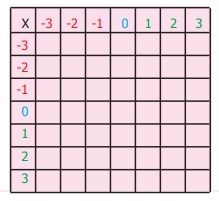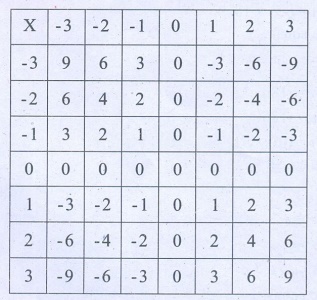Number System | Term 1 Chapter 1 | 7th Maths - Multiplication of Integers | 7th Maths : Term 1 Unit 1 : Number System
Chapter: 7th Maths : Term 1 Unit 1 : Number System
Multiplication of Integers
Multiplication
of Integers
Situation 1
Ramani and Ravi are playing with pebbles in a
heap. Ramani is adding some pebbles to the heap while Ravi removes some
pebbles. First, Ramani adds 3 pebbles. Then she adds 3 more pebbles. She
repeats this 2 more times. Can you say how many pebbles she added in all? Since
adding pebbles is positive we can write ( +3) + ( +3) + ( +3) + ( +3) = +12 or 4
× (+3) = 12
The total number of pebbles added is 12.
Ravi takes out 5 pebbles three times. If we
represent “taking out” as a negative integer then ( −5) + ( −5) + ( −5) = −15
or we can simply put it as ( −5) × 3 = −15. Ravi has removed 15 pebbles from
the heap. This illustrates that multiplication of negative integers is also
repeated addition just like positive integers or whole numbers.
We can draw a number line and visualise the
above multiplication of integers as repeated addition.
4 × 3 = 12 (3 is added four times).

(−5) × 3 =
−15 ((–5) is added three times).

We have no difficulty to understand that a
positive integer like (+7) multiplied by another positive integer like (+8) is
positive (+56). Also, a positive integer like +7 multiplied by a negative
integer like –5 is –35 and +5 × −7 = −35 . But what about a negative integer (
−3) multiplied with another negative integer −5 ? To understand this, let us
observe the following pattern.
( −5)×3 = −15
( −5)×2 = −10
(−5)×1 = −5
( −5)×0 = 0
( −5)×(−1) = +5
(−5)× (−2) = +10
( −5)× (−3) = 15
Note that how in each step the number increase
by 5 from −15 to −10 , from −10 to –5, from –5 to 0. Therefore, the next number
in the pattern will be +5 only and not –5. Similarly ( −5) × ( −2) is a
positive integer 10. So, the product of two negative integers is always a
positive integer.
Try these
1. Find the product of the following
(i) ( −20) × ( −45) =
(ii) ( −9) × ( −8) =
(iii) ( −30) × 40 × ( −1) =
(iv) ( +50) × 2 × ( −10) = –1000
(v) (–30) × 40 × (–1) = 1200
2. Complete the following table by multiplying the integers in
the corresponding row and column headers.

Answer:

3. Which of the following is incorrect?
(i) −55×−22×−33<0
Answer: –55
× –22 × –33 = – (55 × 22 × 33) < 0 it is correct
(ii) −1521× 2511 < 0
Answer: –1521
× 2511 < 0 it is correct
(iii) 2512 −1252 < 0
Answer:
2512 × 1252= 1260 > 0
So 2512 – 1252 < 0 is Incorrect
(iv) +1981× +2000 < 0
Answer:
+ 1981 × + 2000 = +(1981 × 2000) > 0
So + 1981 × + 2000 < 0 is Incorrect
Think
Can you express the product 15 ×
16 as sum or difference of integers?
Yes, here are 4 ways to compute 15
× 16 = +240 .
(i) 15×16 = (10+5)×(10+6)
=100+60+50+30 = 240
(ii) 15 ×16 = (20 − 5)× (10 + 6)
= 200 +120 + (−50)+ (−20) = 240
(iii) 15 ×16 = (10 + 5)× (20 − 4)
= 200 + (−40)+100 + (−20) = 240
(iv) 15 ×16 = (20 − 5)× (20 − 4)
= 400 + (−80)+ (−100)+ 20 = 240
From the above pattern one can
determine the product of two positive integers, two negative integers, one
positive integer with one negative integer.
Example 1.17
Find the value of :
(i) (–35) × (–11)
(ii) 96 × (–20)
(iii) (–5) × 12
(iv) 15×5
(v) 999 x 0
Solution
(i) (–35) × (–11) = 385
(ii) 96 × (–20) = – 1920
(iii) (–5) × 12 = –60
(iv) 15 × 5 = 75
(v) 999 x 0 = 0
Example 1.18
A fruit seller sold 5kg of mangoes
at a profit of ₹ 15 per kg and 3kg of
apples at a loss of ₹ 30 per kg. Find whether it is a profit or loss.
Solution
Profit of 1kg mangoes = ₹ 15
Profit of 5kg mangoes = ₹15×5
= ₹ 75
Loss of 1kg apples = ₹ 30
Loss of 3kg apples = 30×3
= ₹ 90
Loss = ₹90−₹75
= ₹ 15
Example 1.19
Browsing rates in an internet
centre is ₹ 15 per hour. Nila works on the internet for 2 hours in a day for 5
days in a week. How much does she pay?
Solution
Number of hours spent on an internet for a day
= 2 hrs
Therefore, number of hours spent on
the internet for 5 days = 5 × 2
= 10 hrs
Cost of browsing per hour = ₹ 15
Cost of browsing for 10 hours = 15×10
Therefore, the amount paid by Nila for 5 days
= ₹ 150
Related Topics